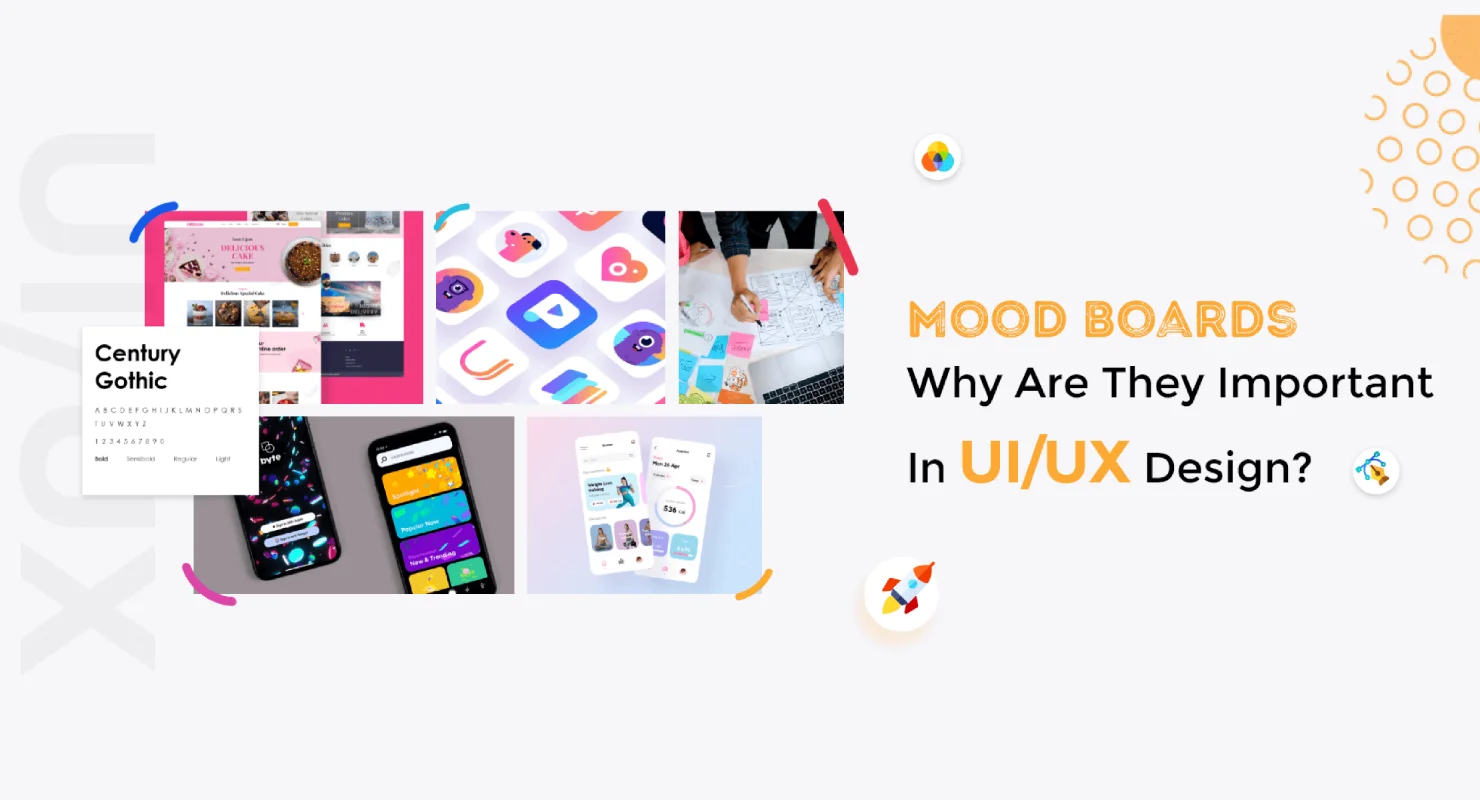Why Mood Boards Are Essential For UI/UX Development
Table of Contents
Subscribe To Our Newsletter

How do you start a design project? How do you tell your brand’s story through ui ux design? How do you organize your thoughts, ideas, and inspirations?
Only one answer- it’s Mood Board.
Mood boards are often known as a jumping-off point for any design project. A mood board draws your imagination initially into a blueprint after discovering, consulting, and identifying the need of your task. It is a transparent display sheet where you can put your experimenting thoughts and find the perfect way to create a final piece.
Designers usually carry this handy tool to bring efficiency to their work. It becomes easy to explain and discuss with colleagues and clients which brings clarity to the design and saves a lot of time.
Moreover, having a pre-defined roadmap also helps in eliminating the risk of failure and/or any major alteration in the final design. So, let us understand the role of Mood Boards in UI/UX development and their essential elements in the designer’s world.
What Is A Mood Board?

Turning an idea into a visual form is what we call a mood board. It is a primary stage where designers create a thoughtful alignment of the images, colors, typography, and sample objects to draw inspiration, set affirmation, get guidance and improve communication in preparing the final ui ux design or project. It also makes the final representation much easier and simple. You can use Mood Boards while designing a brand, website, products, or any other business project design.
Why Mood Boards Are Essential For UI/UX Development?
Mood boards play a crucial role in bridging the gap between concept and creation, simplifying the design process, and building stronger client connections. They provide a visual representation of ideas, ensuring efficient communication and minimizing the risk of design alterations. Discover the power of mood boards for streamlined UI/UX development.
Mood boards are the easiest and smartest way to get a clear picture of what a UI/UX designer is going to create in the near future. It enables the designers to create a separate room of approved designs and ideas that they can use in the UX designing process. Moreover, it also shortens the designing process and simplifies the collaboration strategy.
But to understand the deeper facts, underpinning some of the important points.
Here we go!
1. Bridges The Gap Between Concept And Creation
It is very likely to happen that sometimes what you think is different from what you have finally created and the major reason behind this gap is the lack of communication between the client and designer. The designer remains in dilemma during the whole process of designing and keeps assuming based on the client’s description and discussions. This gap eventually turns into a major problem and creates so many challenges like it becomes a time-consuming task, leads to prolonged feedback, and more like that they land on dreadful designs.
So, mood boards are the best ways to eliminate these errors and enhance the design level. Always try to create a mood board with all the possibilities that you can and discuss it with the client to bring clarity on the concept and the final design creation.
2. Simplifies Designing By Dividing It Into Steps
Do you also strive to deliver the final impeccable ui ux design and put so much effort into it?
Well, you are going absolutely in the wrong direction. In today’s era, smart designing is not about creating the best design in one stroke but is about taking one step at a time to ensure quality in design. Oftentimes, designers are frustrated because of the continuous client rejection and comments but they forget that spending a lot of time without client approval is of no use.
Instead, create a Mood Board and present it to your client as a sample design that is more efficient in every manner. It will give you confidence and guide you on your future path.
3. Builds A Better Connection With Clients
It is not always compulsory that your client appreciate your design work but when your images are aligned with their expectations, then you land up delivering the correct product. Mood boards are the perfect way of communicating your creative ideas to the client because you get to know their thoughts and ideas over it and ultimately it saves your time and effort. Getting initial client feedback is the smart way of reducing confusion and rework.
Also, when you share a mood board then, it is not just a design you are sharing but you indulge in a conversation where all possibilities, pros, and cons are discussed and that helps in building strong relations.
4. Provides A Visual Representation Of The Idea
It becomes quite challenging when you are asking your client to showcase their thoughts visually but they can only explain them in words. In this situation, you struggle with assumptions and get frustrated because you are not able to draw the exact image of what your client is talking about.
So, it’s better to draw a mood board by spending just a few hours on research and study. This strategy will enhance your working efficiency and will simplify your decision-making process.
For instance, you have created a beautiful design after spending resources and time but then the client refused to use the color scheme that you have chosen, or maybe they didn’t like the typography, etc. In that case, both the parties will be disappointed and it will lead to inefficiency.
So, it’s better to go with the mood board, decide everything beforehand, and make sure that you are investing in the design which doesn’t require any major changes in the coming future.
Related Reading: How to Create a Great User Experience Strategy In 2022
Online Portals for Mood Board Inspiration
Continuous research and brainstorming are the key secrets to achieving success in any design. Online portals are doing a similar job. Using these available online portals, users can easily gather a lot of information and fetch inspiration for the further designing process.
Let’s have a look at how these platforms are helping designers in streamlining their tasks and bringing proficiency to their work.
- Pinterest The app name itself explains its usage i.e. pinning the most loved images that you find on Pinterest. This platform is widely used by the general public to draw design inspiration by exploring thousands of graphic designs from all over the world. It allows users to save, share, sort, and upload any image by paying zero amount on it.
- Behance It is a vast platform that can save unique portfolios of the greatest designs from all over the world. It can be used by designers to create mood boards using any kind of images, illustrations, graphics, fine arts, and more. It allows users to assign other members as co-owner so that they can also add their unique ideas and share them with others.
- Dribbble Finding inspiration to create a beautiful design is the first step that designers look for. This platform is the best approach to browse creative designs that can be used to move further in the designing strategy. It covers unique items that help in enhancing your mood boards and adding more ideas to them like design, animation, illustrations, graphics, prototypes, etc.
- Canva This platform is especially for those who are passionate about creating designs and sharing twisting their ideas to bring the best out of them. While creating mood boards this platform can help users to put life in it. Canva has all the design elements that can enhance your creations and help you to carry out experiments in every way. Also, it has pre-built mood boards that can also be used by paying some amount for it.
- Mural When you are working in a team then it is really important to take suggestions of every member. Mural lets users create mood boards in real-time by permitting other users to upload, edit, drag, or enhance the current mood board design. The whole team can take mutual decisions by using polls available here.
- Evernote It is the type of e-note that is used by the users to save their workflow in the form of text, images, videos, and other audio recordings. While creating mood boards, this platform help in organizing and keeping them safe in one place. Similarly, while creating mood boards, it is essential that you align all your designs and concepts that explain your ideas in the best possible ways.
Tools To Design A Mood Board
- Mural
- Milanote
- Evernote
- Dribbble
- Behance
- PatternTap
- Canva

Summing Up!
A mood board is not just a tool but a helping hand for designers to align their work. From visualizing ideas into creative artwork to communicating with clients to understand their queries and requirements, mood boards can convey a clear message to others.
Creating a mood board before initiating the designing process is the current trend in the market which is useful and worth following. We have also discussed various tools and online platforms that can bring you ease from the comfort of your design space.
So, wave goodbye to the hassle and anxieties of reworking on the same project again and again. Mood boards will surely resolve your challenges and help you design a remarkable piece.
Ready to upgrade your brand with visually stunning and user-centric designs?
Featured Blogs
Read our thoughts and insights on the latest tech and business trends
Machine Learning In Healthcare: Applications, Benefits & Future Trends
- April 19, 2024
- Technology
The way we take care of people's health is changing swiftly! Instead of just using tools like scalpels and stethoscopes, doctors are now using super smart computer programs called artificial intelligence, especially one called machine... Read more
Overcome Digital Transformation Challenges in Large Organizations
- April 11, 2024
- Technology
Change is happening fast in the digital world, and for large organizations, it's like climbing Mount Everest – tough, challenging, but definitely worthwhile. Don't worry, though! Even though the journey to digital transformation can be... Read more
Top AI Trends Lighting Up Innovation 2024
- April 10, 2024
- Artificial Intelligence
2024 is set to be a significant year for top AI trends, especially generative AI, following its explosive emergence in 2022 and initial business exploration in 2023. This year, the focus is on making AI... Read more


